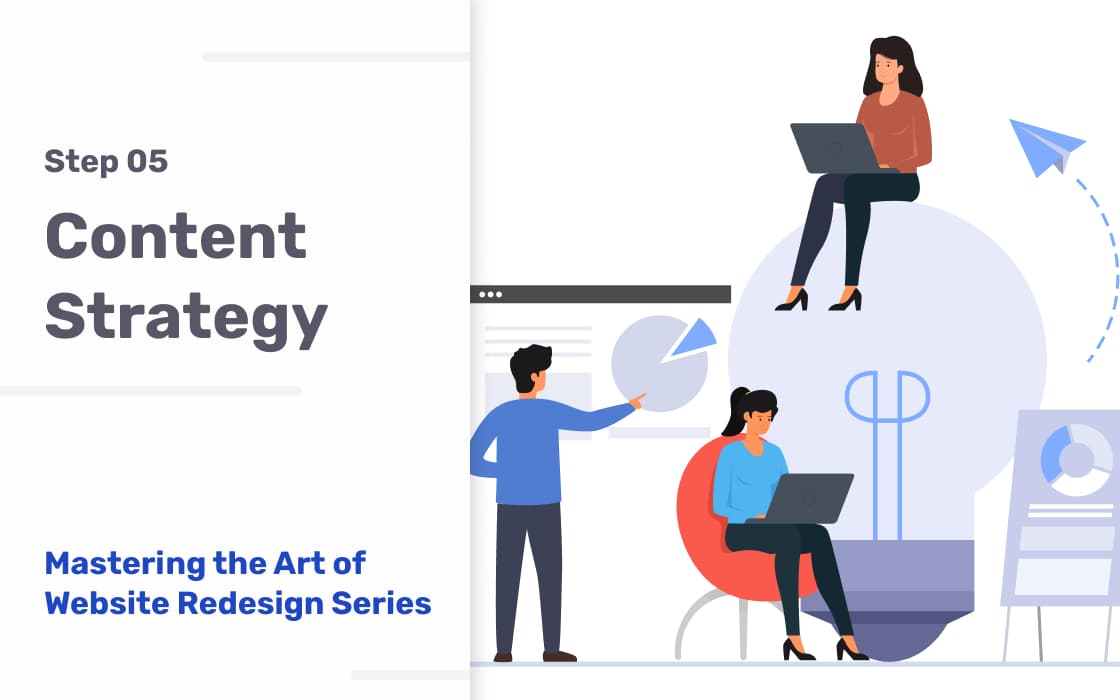In the digital landscape, a website is more than just a collection of pages; it’s a storytelling canvas where your content strategy plays the starring role. Welcome to “Content Strategy: The Heart of Your Website Redesign,” where we delve into content’s crucial role in breathing life into your website.
I’m Shaun, bringing two decades of experience to the table. In my journey through the ever-evolving world of web design, I’ve witnessed firsthand how a well-crafted content strategy can transform a website from merely functional to genuinely compelling. It’s not about what you say but how you say it – your messaging is your brand’s voice, and it needs to be heard loud and clear.
In this article, we’ll explore how an effective content strategy shapes your redesign process, balancing the art of SEO with user experience and mastering the nuances of content migration and management post-redesign.
Whether you’re looking to revamp an existing site or build a new digital presence from scratch, understanding the pivotal role of content strategy is your first step toward a successful redesign. Let’s dive into how you can craft content that captures attention and encapsulates your brand’s essence.
How Content Strategy Shapes the Redesign Process
Content strategy is the guiding force behind a successful website redesign, but it’s crucial to recognize that it doesn’t always entail a complete overhaul of every page. The scope of your content strategy should align with your available resources and time constraints.
- Determining the Scope of Your Content Strategy: Not every redesign project can or should aim to revise every page. Assess the resources and time available to you and decide whether the focus should be on a microsite, top-level pages, or key landing pages. This focused approach allows for impactful changes within practical limits, ensuring that critical areas of your website align with your new strategy.
- Defining Objectives, Audience, and Messaging: Begin with setting clear objectives for your website content. Identify your target audience and tailor your messaging to engage this group effectively. This foundational step ensures your content resonates with your audience and reflects your brand’s values.
- Content Audit and Priority Setting: Perform a content audit focusing on areas identified in your scope. Assess each piece for relevance and alignment with your new messaging strategy. Prioritize updating content that will have the most significant impact in line with your redesign goals.
- Structured Content Hierarchy and Integration: Develop a structured content hierarchy that supports your redesigned website’s objectives and enhances user experience. Prioritize the organization and presentation of content to effectively communicate your key messages, especially in the areas you’ve identified as most impactful.
- Aligning Content with User Journey: Align your content with the user journey, ensuring each piece serves a purpose along the customer’s path from discovery to decision. This strategy is particularly crucial for the high-priority areas you’ve identified, ensuring these key touchpoints effectively guide and inform the user.
- Consistency Across Key Areas: Maintain consistency in messaging, tone, and style across all prioritized areas of your website. A unified approach strengthens your brand identity and amplifies your message where it matters most.
By strategically defining the scope of your content strategy and focusing on high-impact areas, you can achieve a meaningful and feasible redesign. This approach ensures that your website not only looks fresh but communicates more effectively, maximizing the return on your investment in the redesign process.
Balancing SEO with User Experience in Content Creation
Achieving a balance between SEO and user experience (UX) in content creation is pivotal in website redesign. This balance becomes even more crucial when considering the need to preserve the SEO value of existing high-ranking content.
- Tactful SEO Integration in Content: While infusing SEO into your content, be mindful of existing pages that already perform well in search rankings. A light touch is needed here to avoid disrupting their SEO strength. Update these pages cautiously, ensuring that key SEO elements like keywords, meta tags, and URLs remain intact or are only gently modified.
- User-Friendly Content as a Priority: Prioritize the user’s experience by crafting content that’s engaging, informative, and easy to navigate. For high-ranking pages, make user experience improvements that don’t significantly alter the content’s SEO structure.
- Balancing Keywords with Natural Language: Integrate keywords naturally. In high-ranking content, review the current keyword strategy and make adjustments only if they contribute positively to the user experience without compromising the page’s SEO performance.
- Mobile Optimization and High-Ranking Content: Ensure content is mobile-friendly, including your top-performing pages. This includes responsive design and readability on smaller screens, done in a way that preserves the SEO integrity of these pages.
- Adapting Content for Voice Search and Featured Snippets: Optimize new and existing content for voice search and aim for featured snippets. For high-ranking content, refine it to answer queries directly, ensuring any changes align with current SEO best practices.
- Careful Evaluation and Adaptation of High-Performing Content: Regularly review the performance of your content, especially high-ranking pages. Any adaptations should be measured and tested to ensure they enhance both SEO and user experience without disrupting the established SEO success.
Incorporating these practices ensures your content strategy not only enhances the overall user experience but also respects and preserves the SEO value of your existing high-ranking pages. This approach leads to a redesigned website that continues to perform well in search engine rankings while offering an improved experience for your visitors.
Strategies for Content Migration
Content migration in a website redesign presents both challenges and opportunities. You have a new content strategy but now you need to get your old content whipped into shape. I’ve experienced this with websites that had thousands of pages dating back 10+ years. In most cases, this is the part of a project that causes everyone to wince and feel frustration. Here is some advice:
Planning for Migration
Think of content migration like changing the tires on a moving car. Your existing website will still be active during the redesign, so it’s crucial to have a solid plan for capturing any changes or additions to the content. This requires meticulous tracking and coordination to ensure that no critical updates are missed during the transition.
Structured vs. Unstructured Content
Structured content, such as database entries or content managed through specific fields in a CMS (think calendar events or products), is generally easier to migrate because of its consistent format. This migration is an opportunity to “fix,” “massage,” or enhance this structured data, improving its organization and quality.
Unstructured content, like text in various formats and styles or embedded within different page designs, may require manual re-entry. This is often the case when the content needs to align with an updated content strategy or messaging. While more labor-intensive, it provides an opportunity to refine and improve the content.
Automating the Migration
If feasible, build a bridge between your old website and the new CMS to automate the migration of content. This can be set up to transfer content daily or weekly.
Implement an automated reporting system to track the success of the migration. This transparency is vital as it allows everyone involved in the project to see real content in the new site as it develops, making adjustments as needed.
Opportunities in Migration
Use the migration process as an opportunity to review and optimize content. It’s a chance to discard outdated information, improve SEO, and ensure consistency with your new messaging and strategy.
Encourage feedback from different departments during the migration process. This can provide valuable insights into how content is used and perceived across your organization, leading to a more effective overall strategy.
Content migration is a critical phase of your website redesign, involving careful planning and execution. By approaching it methodically, you can ensure a smooth transition to your new site while taking the opportunity to enhance and refine your digital content.
Conclusion
As we conclude our exploration of content strategy in a website redesign project, it’s clear that the journey of transforming your site involves much more than just visual updates. Content, both in its creation and migration, stands at the heart of this transformative process.
The strategies we’ve discussed – from meticulously planning your content migration to understanding the nuances of structured and unstructured content – are vital for a smooth transition to your new website. Remember, the migration phase isn’t just about moving content; it’s an opportunity to refine, optimize, and align your content with your updated strategy and messaging.
As you embark on this journey, keep in mind that successful content migration requires both a well-thought-out plan and the flexibility to adapt as needed. It’s a balancing act between preserving valuable SEO gains from existing content and embracing the chance to improve and update your content for a better user experience.
In the end, a thoughtful approach to content strategy and migration not only enhances the effectiveness of your redesigned website but also reaffirms your commitment to providing valuable, relevant, and engaging content to your audience. With these strategies in hand, you’re well-equipped to ensure that your website redesign is not just a new look, but a comprehensive upgrade of your online presence.
Mastering the Art of Website Redesign Series
Post-Launch
How to track key metrics to measure the success of your redesign, the importance of gathering user feedback, and the necessity of making iterative improvements.

